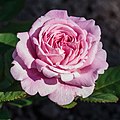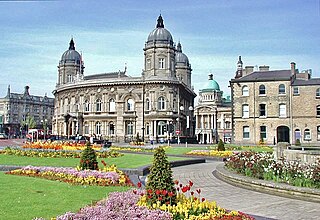
Queen's Gardens is a sequence of gardens in the centre of Kingston upon Hull, England. They are set out within a 9.75-acre (4 ha) area that until 1930 was filled with the waters of Queen's Dock. As the dock was not fully filled in, the gardens are largely below the level of the surrounding streets.
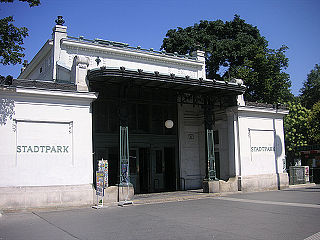
The Stadtpark in Vienna, Austria is a large municipal park that extends from the Ringstraße in the Innere Stadt first district up to the Heumarkt in the Landstraße third district. The park is divided in two sections by the Wienfluss, and has a total surface area of 65,000 square metres. Scattered throughout the park are statues of famous Viennese artists, writers, and composers, including Hans Canon, Emil Jakob Schindler, Johann Strauss II, Franz Schubert, and Anton Bruckner. The opulent Kursalon building on Johannesgasse, with its broad terrace that reaches into the park, is the site of popular waltz concerts.

Coburg is a town located on the Itz river in the Upper Franconia region of Bavaria, Germany. Long part of one of the Thuringian states of the Wettin line, it joined Bavaria by popular vote only in 1920. Until the revolution of 1918, it was one of the capitals of the Duchy of Saxe-Coburg and Gotha and the Duchy of Saxe-Coburg-Saalfeld.
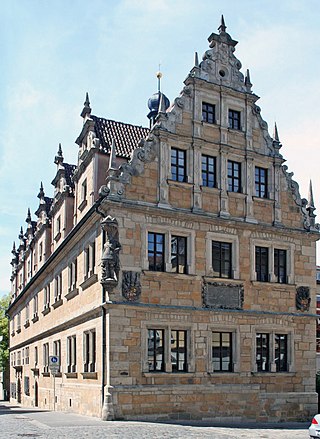
The Casimirianum, known to the students as the "Casi", is a Gymnasium in Coburg, Bavaria. It was founded in 1605 by Johann Casimir, the Duke of Saxe-Coburg (1564–1633), and named after him. Today the Casimirianum is a linguistic and humanistic high school with the curriculum including Latin from 5th Grade, English from 6th Grade, and Italian, Greek, French or Spanish as the third compulsory foreign language. With the school year of 2009–10, the program was expanded with a scientific-technological branch with Latin as a second language. The Casimirianum was once involved with a German pilot program, "The European Gymnasium" and was one of 44 Model Schools of "MODUS21", but both programs were closed by 2009.

Confederation Park(French: Parc de la Confédération) is a public park and National Historic Site of Canada, located in the downtown core of Ottawa, Ontario, Canada. It is bordered on the south by Laurier Avenue and Ottawa City Hall; on the east by the Rideau Canal and National Defence Headquarters; on the north by the Mackenzie King Bridge, the Rideau Centre and the National Arts Centre; and to the west by Elgin Street and the Lord Elgin Hotel.

Putbus is a town on the southeastern coast of the island of Rügen, in the county of Vorpommern-Rügen in the state of Mecklenburg-Western Pomerania, close to the Baltic Sea. The town has 4,741 inhabitants and is a significant tourist destination with numerous seaside resorts. It is the oldest resort on the island and has been formally recognised by the state as a resort town since 1997.

Rietberg is a town in the district of Gütersloh in the state of North Rhine-Westphalia, Germany. It is located approximately 10 km south of Gütersloh and 25 km north-west of Paderborn in the region Ostwestfalen-Lippe. The town is located at the river Ems. There are 28,878 people living in Rietberg.
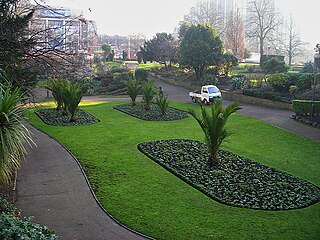
The Queen's Gardens is a public garden in the centre of Croydon, South London. The gardens are bordered by Croydon Town Hall, Bernard Weatherill House, the site of the former Taberner House, Park Lane and Katharine Street.
Franz Reinhold Schwede was a Nazi German politician, Oberbürgermeister of Coburg and both Gauleiter and Oberpräsident of Pomerania. An early supporter of Adolf Hitler in Coburg, Schwede used intimidation and propaganda to help elect the first Nazi-majority local government in Germany. This contributed to a personality cult surrounding Schwede and he became known as "Franz Schwede-Coburg." During World War II he ordered secret executions of the infirm and mass deportations of Jews. He also played a key role in abandoning the Pomeranian civilian population to the advancing Red Army, while escaping their fate himself. In 1945 he was captured by the British Army and in 1948 he was tried and convicted of war crimes.

Landestheater Coburg is a medium-sized three-division theatre in Coburg, Bavaria, Germany. Located on Schlossplatz, a central square, the Neoclassical building has 550 seats. In 2008, the theatre employed 250 permanent staff and 100 part-time employees.

The Veste Coburg is one of the best-preserved medieval fortresses of Germany. It is situated on a hill above the town of Coburg, in the Upper Franconia region of Bavaria.

The Różanka Rose Garden, is a two-hectare botanical garden in the Łękno area of Szczecin, Poland.
The Lörrach Sculpture Path is a Sculpture trail of 23 works and fountains through the southern German city of Lörrach.

Schloss Ketschendorf is a Gothic Revival residence, located in Ketschendorf, at the foot of the Buchberg, in the town of Coburg, in the state of Bavaria, Germany.

The Free State of Coburg emerged from the Duchy of Saxe-Coburg and Gotha at the end of the First World War. It existed from November 1918 until its union with the Free State of Bavaria on 1 July 1920.
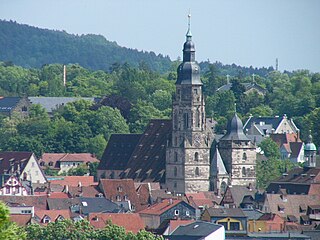
Morizkirche is a Protestant church dedicated to Saint Maurice in Coburg, Bavaria, Germany, and is the town's oldest church. Its earliest remaining structures date back to the 14th century, which superseded a church from the 12th century. Martin Luther is known to have given several sermons there in 1530 A.D. This church currently houses the family tomb of the Dukes of Coburg. In modern times, Morizkirche serves as the main church for the congregation of St. Moriz. Due to the height of its towers, the church is one of the landmarks of Coburg. It is also one of the most important Luther memorial sites in southern Germany.
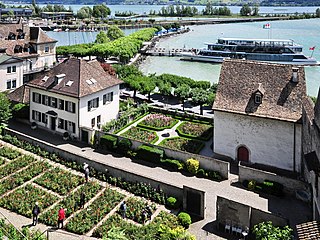
The Rapperswil Rose Gardens are privately established small rose gardens probably dating back to the early years of the former independent town of Rapperswil. They are located in the present city of Rapperswil-Jona, Canton of St. Gallen, in Switzerland.

The Colombischlössle is a manor house in the city centre of Freiburg im Breisgau where the eponymous archaeological museum is situated.

The Platz der Alten Synagoge is a square in Freiburg, Germany. With a size of 130 square metres, it is the second largest square in the city after Minster Square. The square is named after the old synagogue, which was destroyed during the Kristallnacht in 1938. The synagogue had been built in 1869/1870 to the southwest of today's location of the square.
Ferdinand Lepcke (or Lepke) (1866–1909) was a German sculptor, who in particular realized two major monuments in Bydgoszcz: the Deluge Fountain and The Archer. He received a golden medal at the Great Berlin Art Exhibition and, the Berlin Minister for Spiritual Education and Medical Affairs awarded him the title of professor.


























